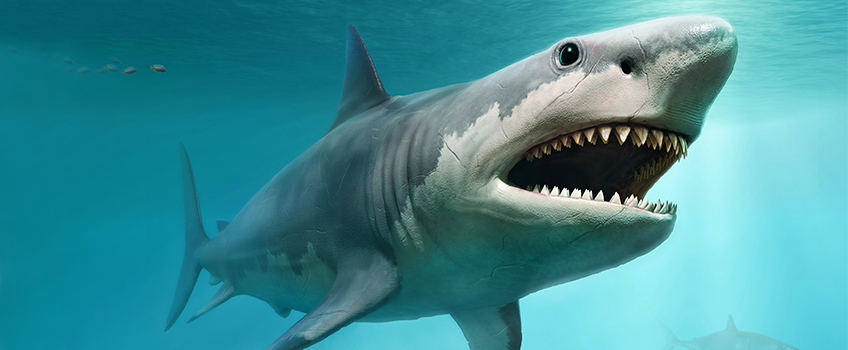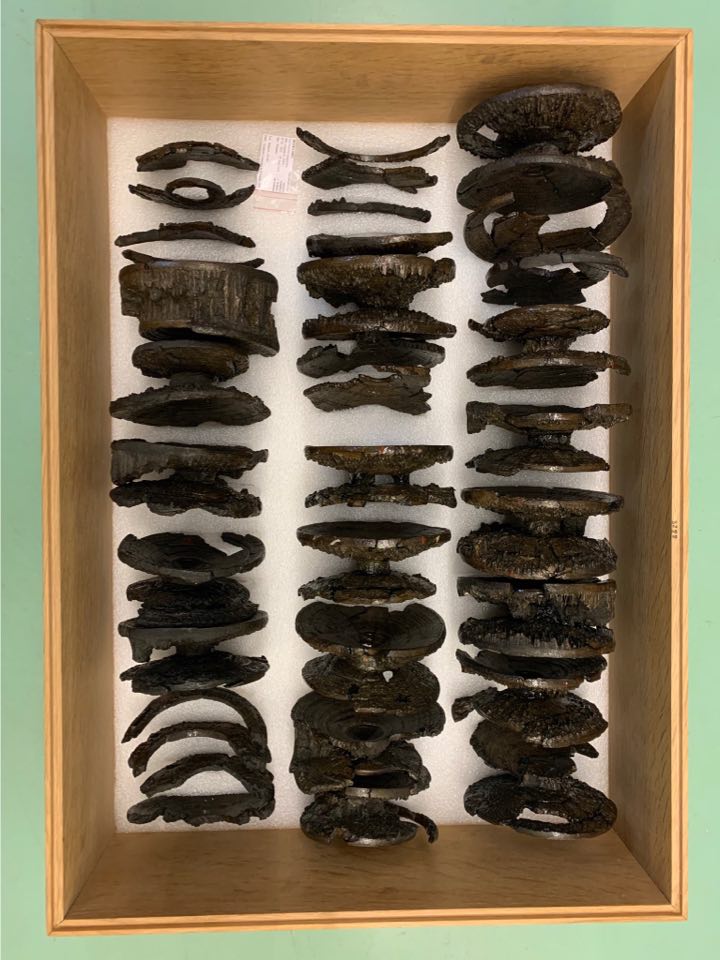Jaw-dropping Research Reveals Megalodon Mysteries

Galloway, N.J. - Fossilized teeth and vertebrae are all that remain from the extinct Megalodon, the largest shark to have ever hunted our oceans. But that was just enough for a team of paleontologists to reconstruct pieces of the prehistoric predator’s life history.
Matthew Bonnan, professor of Biology at Stockton University, was a co-author on a paper detailing one Megalodon shark’s story and its dark secret revealing how it grew so large before birth.
Fossils Tell Unusual Tale
Bonnan read the CT scans of three fossil vertebra from a Megalodon that died 15 million years ago. The story they told was that the shark likely ate a sibling while still in its mother’s uterus. It was born 2 meters long, lived 46 years and reached a maximum length of 9.2 meters.
Fossils have a lot to say to those who can extract the stories with technology. Complete shark skeletons in the fossil record are rare, but their hard vertebrae and teeth preserve more easily.
“Shark vertebrae are made up of calcified cartilage which is why they were preserved in the fossil record. It’s not the rubbery cartilage at the end of your nose or in your ears. It’s a special type of cartilage that has minerals in it so it’s more likely to be preserved as a fossil. That's why we have fossils of Megalodons,” said Bonnan.

The Megalodon vertebrae that Bonnan studied are located in Brussels at the Royal Belgian Institute of Natural Sciences. Photo: Annelise Folie/ RBINS
Long-Distance Research
One of the best preserved and most complete Megalodon specimens in the world is located a few thousand miles across the North Atlantic Ocean, safely catalogued in the Royal Belgian Institute of Natural Sciences’ conservatories in Brussels. The three vertebra that Bonnan analyzed came from that specimen.
During the pandemic, Bonnan’s longtime friend in the paleontology community, Kenshu Shimada, a shark expert, reached out to him to study the shark in Belgium via CT scans that could be sent by email.
The largest and best-preserved vertebra were put in a CT scanner in Belgium and then the files were emailed to Bonnan in New Jersey. The complete collection of 150 vertebrae remained in the museum alongside a drawer full of teeth that were found near the vertebrae but aren’t necessarily from that same shark.
The vertebrae were unearthed in the 19th century in Antwerp, Belgium. When they were discovered, “they weren’t all strung together, but were found in the same layer of rock in the same location suggesting they came from the same animal,” said Bonnan.
Growing in Circles
A CT scan is made up of hundreds of x-ray images that build a three-dimensional model. Bonnan was able to create virtual cross sections of the vertebrae to show the interior series of concentric bands.
“The way shark vertebrae grow is that they add layers on just like trees add on rings. So, just like you’d count rings in a tree to tell how old it was, you can count the rings you find in a shark vertebra to estimate the age of the animal,” explained Bonnan.
Bonnan counted 46 circles in the largest vertebra and the same number in the two other vertebrae, which gave the team the shark’s age of 46 years old—or young, since they can live up to 88-100 years.
The need to sacrifice a rare specimen by slicing it open to count rings was eliminated by x-ray technology. “The only way you could have done something like this in the past was to take a vertebra and saw it in half,” he explained.
With an age, the team could then calculate the shark’s length by multiplying the age by a growth rate. The shark grew to 9.2 meters. The largest Megalodons were up to 15 meters.
The growth rate comes from information gathered from living ancestors.
“Because we have living sharks where people have done things like compared the size of the vertebrae to the number of rings to a known body size, we can use that information to estimate body size in an extinct shark,” said Bonnan.
Natural Born Predators
Megalodons belong to the order of sharks known as the Lamniformes and give live birth.
“The offspring hatch in their mother’s uterus and they often feed on unfertilized eggs and maybe some fertilized eggs. Sometimes there can be intrauterine cannibalism, and so then when they are born, they tend to be larger than they would be if they simply hatched out of an egg,” explained Bonnan.
A 2-meter baby shark likely grew to that size from eating a sibling. “We are talking a baby shark the size of your average basketball player. To put that in perspective, a Great White shark can get up to 5-6 meters in length as an adult,” said Bonnan.
A key characteristic in the growth rings, allowed the team to back-calculate the shark’s size at birth.
“When these sharks are born, the angle at which these growth rings are being laid down changes in a way that you can see in CT scans. When we looked at the cross sections of these vertebrae in these x-rays from the CT scan, we could see where that angle change happened and therefore you know what size the shark was when it was born,” said Bonnan.
Defying the Odds
“Most of the animals that get really big in the ocean tend to be some kind of filter feeder,” said Bonnan.
Today’s largest sharks are the filter feeding whale sharks and basking sharks, and the biggest whales tend to be plankton feeders.
“What’s interesting is that you have an animal Megalodon that was an active predator but growing 14-15 meters in length and giving birth to 2-meter-long babies. We just don’t see anything like that today in terms of having animals that big that are primarily carnivorous,” he explained.
Predators burn a lot of calories in pursuit of prey.
“If you are a filter feeder or plankton eater, there are a lot of calories that you can take in in one gulp, so you don’t have to be as picky about what you eat. You can swim through the ocean and open your mouth and just engulf tons and tons and tons of these little organisms and that’s going to be able to sustain you at a large size. If you're a predator you have to actively pursue prey, eat it and break it down. There are these things that happen that we assume limit the upper size of the animal,” said Bonnan.
Somehow the Megalodon figured out how to be an apex predator and grow to be the largest shark in the ocean, and that feat remains a mystery.
- Reported by Susan Allen
News Headlines
New York Times: Baby Megalodons Were 6-Foot-Long Womb Cannibals, Study Suggests
Forbes: Megalodons Were Born Big After Eating Unhatched Eggs In The Womb
LiveScience: Megalodon shark mamas had human-size cannibal babies
Business Insider: Megalodons may have grown to the size of school buses by eating their shark siblings in the womb, new research suggests


